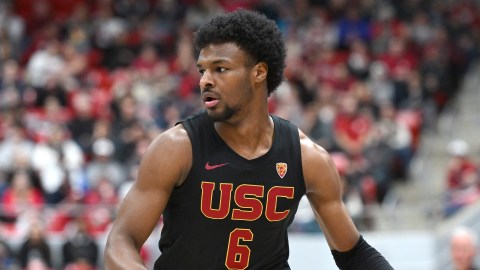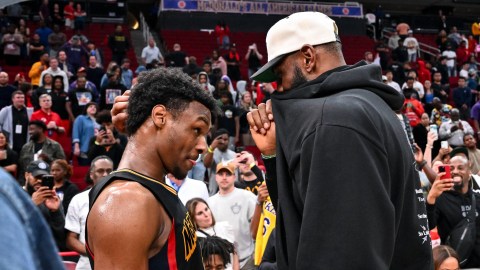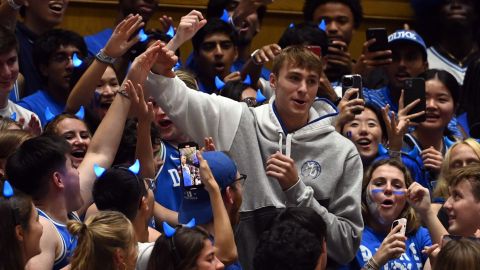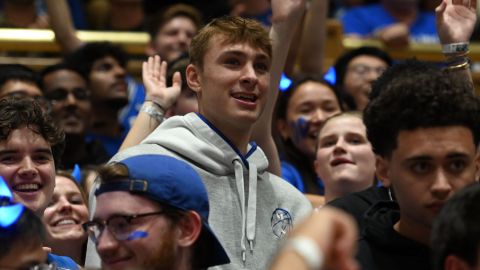 Welcome to draft week.
Welcome to draft week.
At long last, the 2014 NBA draft is just days away. Shortly after 8 p.m. Thursday, the Cleveland Cavaliers will make their selection at No. 1 to tip off the proceedings.
Whether you have exhaustively analyzed every mock draft or are just diving into your draft research now, there is only so much to learn from the educated guessing in a mock draft format. As an alternative, we will rank the top players at each of the rough positions — guards, forwards and centers — from the class of 2014.
First up, the top 15 guards. Check back Tuesday and Wednesday for the top forwards and centers, leading into our final mock draft Thursday.
1. Dante Exum, Australia (G, 6-6, 180) — Exum has been discussed as a potential No. 1 pick, although it is more likely he falls between three and five. He has point guard skills in a shooting guard’s body, although his shooting needs to improve to fulfill his potential at either position.
2. Marcus Smart, Oklahoma State (PG, 6-3, 225) — Not quite a pure point guard, not quite a pure scoring guard, Smart nonetheless might be the most NBA-ready lead guard in this draft. He plays with fire at both ends, which helps compensate for a jump shot that is still a work in progress.
3. Gary Harris, Michigan State (SG, 6-4, 210) — A strong defender and a clutch shooter, Harris could be a key cog on a championship squad some day. At the very least, he should be one of the better sixth men in the league, whichever team he ends up with.
4. James Young, Kentucky (SG, 6-6, 215) — A streaky shooter, Young is not as sure a bet as Harris or Michigan’s Nik Stauskas, who appear to be dead-eye spot-up shooters in the NBA at worst. Young has NBA size and wingspan, but after playing only one season at Kentucky, his game needs a lot of cleaning up.
5. Nik Stauskas, Michigan (SG, 6-6, 205) — At his size, Stauskas probably would have found a place in the NBA merely as a 3-point shooter. But his growth last season into a capable pick-and-roll ballhandler made him a potential late-lottery pick. While defense is his weakness, he knows where to be; he just lacks the athletic ability to make the play.
6. Zach LaVine, UCLA (SG, 6-5, 180) — Nobody on this list, save maybe Exum, approaches LaVine from an athletic standpoint. He recorded a 41.5-inch vertical leap at the Chicago combine. With another year in school, he might have been a top-five pick. As it is, he ranges anywhere from the top 10 to the late first round on draft boards.
7. Tyler Ennis, Syracuse (PG, 6-2, 180) — About half the teams in the league could draft Ennis, and he would immediately be their best pure point guard. Unfortunately for Ennis, pure point guards are becoming less sought as more clubs embrace the idea of having two combo guards on the floor at one time, rather than a designated point and off-guard.
8. C.J. Wilcox, Washington (SG, 6-5, 195) — Shots, shots and more shots. At 23, Wilcox does not have the upside of some younger players, and shot-making might be his one NBA-caliber skill. But within that one skill, his versatility is enormous. Wilcox and put the ball in the hole off the catch, off the dribble and coming off screens.
9. Shabazz Napier, UConn (PG, 6-1, 180) — Napier pulled off a difficult trick in his four years in Storrs: He became a more efficient scorer as he assumed a larger share of the scoring burden. That is rare even for players winning NBA scoring titles. His winning reputation and competence in running a pick-and-roll also reflects favorably.
10. Jordan Adams, UCLA (SG, 6-5, 220) — Adams knew how to put the ball in the bucket at the college level, but without elite height or athletic ability, will he have the same success in the pros? He has been compared to a poor man’s James Harden, though he is nowhere near as good a ballhandler, but his 6-foot-10 wingspan could help offset a modest 29.5-inch vertical.
11. Elfrid Payton, Louisiana-Lafayette (PG, 6-3, 190) — It is one thing to be quick or energetic. It is another thing to be both. Payton was a one-man fast break for the Ragin’ Cajuns, even off opponents’ misses. As half-court defenses become more elaborate, the ability to push the ball and score before the opponent can get set is of growing importance.
12. Spencer Dinwiddie, Colorado (PG, 6-6, 205) — Some team could end up with a steal in Dinwiddie in the late first or early second round. He passes well for a shooting guard and plays well off the ball for a point guard, although he’s not completely either. A torn ACL also added a hit to his draft stock.
13. P.J. Hairston, D-League/North Carolina (SG, 6-6, 220) — Serious off-court issues led Hairston to get bounced from UNC, but he proved last season with the Texas Legends that he can play. He poured in 21.8 points per game for the Dallas Mavericks’ minor-league affiliate, though his 0.8 assists per game suggests he needs to look for his teammate a bit more.
14. Semaj Christon, Xavier (PG, 6-3, 180) — One of a handful of “pure energy” combo guards, along with Payton and Nevada’s Deonte Burton, Christon is a relentless shot-creator who gets to the free throw line. His basketball IQ is atrocious, however, and his shooting mechanics need work.
15. Deonte Burton, Nevada (PG, 6-1, 190) — Strong and springy with the ability to finish out of a pick and roll, Burton has the look of a score-first backup point guard. If he can make plays for others, he did not show it in college, but that is sure to be an area of improvement for him in the NBA.
Photo via Twitter/@sportingnews



